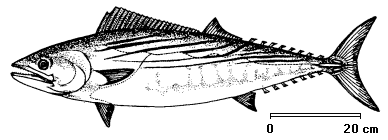
Sarda sarda Bloch, 1793

Synonyms: Scomber sarda Bloch, 1793; Scomber pelamis Brunich, 1763; Scomber sarda Schneider, 1801; Thunnus sardus Risso, 1826; Pelamys sarda Cuvier, 1832; Sarda mediterranea Jordan, 1883; Sarda sarda Banarascu, 1964
Common names: Engl: Atlantic bonito; Bulg: Palamud; Georg: Atlantikuri pelamida, Pelamida; Rom: Palamida; Russ: Pelamida; Turk: Palamut-torik; Ukr: Pelamida
Order: PERCIFORMES
Family: SCOMBRIDAE
Taxonomic descriptions: A small, relatively narrow-bodied tuna; mouth rather wide with sharp snout; large mouth, oblique; the upper jaw reaching to the hind edge of the eye or beyond; the lower jaw almost equal with the upper one; strong teeth on jaws and palatins; dorsal fins close together, the first (spiny) dorsal fin very long and straight or only slightly concave in outline; the second fin smaller; the anal fin short; pectoral fins short, triangular with large base; ventral fins short, in same plan; lateral line conspicuously wavy; two flaps (interpelvic process) between the pelvic fins; body entirely covered with scales which are minute, except on the well developed corselet (area behind the head and around the pectoral fins covered with larger and thicker scales); on each side of the slender caudal peduncle, a well developed lateral keel between two small keels located at the bases of the caudal fin lobes; colour of the back and upper sides steel-blue, with 5 to 11 dark oblique stripes running forward and downward; lower sides and belly silvery; 7 to 10 dorsal, and 6 to 8 anal finlets. Size: Maximum - 80 cm; Common - 30 to 50 cm.
 IUCN
Status:
IUCN
Status:
World level:
Black Sea Regional level:
Subregion level: CR
Distribution:
Habitat type, Critical habitats, Limiting factors: Pelagic migratory species often schooling near the surface in inshore waters, mainly over the continental shelf. Common throughout the Mediterranean, in the Black Sea and in the tropical and subtropical waters of the Atlantic; present also in higher Atlantic latitudes, up to the coasts of Scandinavia and Ireland. Pollution, overfishing.
Biology: Thermofile and stenohaline, the majority of individuals spend the winter in the Marmara and Aegean Seas. In April, small schools of similar sizes and sexes enter the Black Sea, staying here up to late in October. Feeds mostly on fishes, particularly small clupeids, gadoids and mackerels; make the autumn migration; the spawning in many portions, from May to mid July. Growth ratio is faster; longevity - 12 years.
Population trends: During 1954-1960, S. sarda was the main species in offshore fishing performed in the Romanian Black Sea waters (99.8% in 1954 and 1955; 96.0% in 1956). In 1954, caught 34,000 kg were caugth in front of the Sulina-Sf.Gheorghe branches; in 1955 and 1956, in June-August, in the Portita-Constanta zone - 150,000 kg. In the 1960ís, all Black Sea countries together caught a total of 3 x 104 t; after 1960, its populations drastically diminished.
Threats: Strong pollution of Marmara Sea and prebosforic zone; overfishing.
Conservation measures taken: On the Romanian Black Sea littoral no specific tools were used.
Conservation measures proposed: Measure for a decrease of the anthropogenic pressure in the Black and Marmara Seas, assuring the passage through the fishways of the Bosphorus into Black Sea. Banning the swordfish fisheries in certain periods in the Black Sea. Establishing a special recovery programme in the entire Black Sea.
References:
Compiled by: G.Radu, F.Verioti